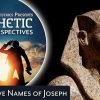What is the importance of Biblical Archaeology?
This question was posed to Dr. James Fleming, one of the most knowledgeable teachers of Biblical Archaeology, on our show Christ in Prophecy. Dr. Fleming has lived and taught in Israel for the past 37 years at Jerusalem University College and at the Hebrew University. His first claim to fame is that he discovered the ancient Eastern Gate buried beneath the current one. Dr. Fleming has walked or motorcycled about every square mile of Israel, and is so familiar with Israel past and present that Israeli tour guides come to him for training. He now operates the Explorations in Antiquity Center in LaGrange, Georgia, an interactive museum where people here in the U.S. can experience the life and times of Christ.
Dr. Fleming: If a Christian is serious about their faith, they need to know two worlds very well. They need to know the world of the Bible which is their faith document so that they can better understand what those words would have meant in their time and place. Secondly, they need to know the world in which they live so they can properly correlate the similar issues today that the ancient text can address, like for example an ancient prophecy to understand its proper application in the world today.
Dr. Reagan: How about giving us some examples on how understanding archaeology will better help us understand a biblical story or something else in the Bible?
Dr. Fleming: Well, of course, every page has those. But, for example, sometimes a word can be translated in two ways, and unless you understand what the original text meant you wouldn’t know which it the correct usage.
This is going to be surprising to some, but the words “upon” and “against” are the same in Greek. The words “lift up” and the words “take away” are also the same. Now, vines in the ancient world didn’t have wires holding up all the branches like modern vineyards have. At the Last Supper, Jesus in John 15 said that any branch that bears not fruit “I will…” normally it is translated “take away,” but the same word is normally translated actually 75% of the time as, “I will lift up.” It is the word used in the Ascension story. Well, the translator pictures modern vines already lifted up and so translates it, “I will take away.” But, there is a very important difference in the meaning between “lift up” and “take away.” Did you know that if a vine has a branch that touches the ground without wires holding it up it will make its own root?
Dr. Reagan: No, I didn’t know that.
Dr. Fleming: The vine will no longer take its nourishment from the deeper mother root of the vine. And so, what the vine dresser does is stick a rock under the vine and yet another one to lift it up. Jesus in essence is really saying, “Abide in me, keep your nourishment coming from my deeper root, and I will lift you up so you won’t support your shallow own root.” You have to know how vines were grown at the time of Jesus to help interpret the text. This is just one little example.
Dr. Reagan: Give us another example as you must be a walking encyclopedia of examples.
Dr. Fleming: Of trivia!
Dr. Reagan: But, they help us better understand what the Bible is saying.
Dr. Fleming: Yes. How about a specific discovery? For example, let’s discuss grave customs. In Bible times you never threw away old clothing. You would use them as rags and tear them up into strips to swaddle or wrap infants and you even swaddled the dead. The reference should always be “grave cloths,” not “graves clothes,” because they would wrap a body with torn up strips of cloth.
The Shroud of Turin would not be an example. In later periods you will certainly have a burial shroud, but not in biblical times. They would wrap a body. Now, when you wrap a body it is fine going up to the shoulders, but then you have to come to the neck. The head wrapping are always a little bit separate from the body wrappings.
Nathan Jones: That would explain then why Lazarus had to be untied. He didn’t pull off a shroud. He had to be untied.
Dr. Reagan: Or, why there was a separate head wrapping for Jesus.
Dr. Fleming: If someone had stolen the body and left the grave wrappings there would be one pile of grave cloths. But, if the body wrappings were one place and there was the head wrappings separate from them… this is what made Peter believe, right, that the body was gone but the wrappings were undisturbed.
I don’t want to make this a too literal thing because obviously the mystery of the Resurrection presence of Christ is the much more important reality than just looking at grave cloths. But, that is what it would have meant if you stopped to ask what were burial customs in the time of Jesus.











Hello Nathan
I have no desire to support the ‘Shroud of Turin’ theory; but if I may play ‘devil’s Advocate’?
Because it was evening, the day of preparation before a Sabbath, they were in a hurry, so may not have used the traditional time consuming strips of cloth (othonian) to bandage the body as implied in John19:40.
Maybe Matthew's 27:59;Mark 15:46 and Luke23:53 version (sindon)which seems to be more like the ‘shift/ nightshirt that wealthier people slept in at night.
Mark15:42Joseph of Arimathea was wealthy and provided the clean linen, maybe just a bolt of cloth with the intention of returning after the two Sabbath’s and do a proper job. Mark16:1,2; Luke24:1; Matt28:1
I don’t want to be right, but I can see why this would be queried.
Maranatha!
Sue
Two issues I have with the Shroud as a legitimate picture of Christ: 1) the way the bottom nail goes through the front of both feet, rather than in each side as around Jerusalem most were nailed to existing trees, 2) God doesn't leave artifacts around to be worshipped.
Still, seeing all the aweful damage that man sustained sure helps us better understand the torture Christ endured on our behalf.
Hello Nathan
Shroud or linen strips aside; I agree with both of your issues.
In addition:
3. The figure had a broken nose. John19:36 “For these things were done, that the scripture should be fulfilled, A bone of him shall not be broken”.
4.The victim had long hair. Jesus was a Nazarene, not a Nazzerite. In the catacombs of Rome, early Christian drawings of Jesus and the disciples have near crew cuts.
1Cor11:14.”Does not even nature itself teach you that if a man has long hair, it is a DISHONOUR to him”?
Ezekiel 44:20 (Priests) “They shall neither shave their heads nor let their hair grow long, but they shall keep their hair WELL TRIMMED.
(Jesus was not imprisoned long enough for there to be any perceptible hair growth. It takes about four weeks for hair to grow half an inch.)
5. There are too few ‘whip and beating cuts’. imo
6. No bloodied injuries around the beard. Isaiah50:6
7. Jesus is our High Priest. This figure’s beard was cut into a V . Lev19:27.
That man may have been a crucifixion victim and wrapped in a shroud, but it isn’t Jesus
who was so badly ‘marred’ He was un-recognisable Isaiah 52:14.
Sue
The Gospel account also list two items of burial clothing, the facial napkin as well as the body wrap. The Shroud is a one piece item. Lazarus while resurrected from the grave also had this facial napkin about his head, this was the common tradition. This would identify the Shroud as unique but not the burial cloth of Christ.
Sue, excellent point about the beard shape! I'd never considered that. Your academic prowess has me wondering what career path besides motherhood you lived, or the world missed out on. I remain your student. 🙂
Dearest Nathan
I was a qualified 'Hairstylist'in my salad days. Hair interests me. 🙂
Sadly, I'm not academic, I am merely curious and fairly observant, and if I don't know, I Google it. 😉